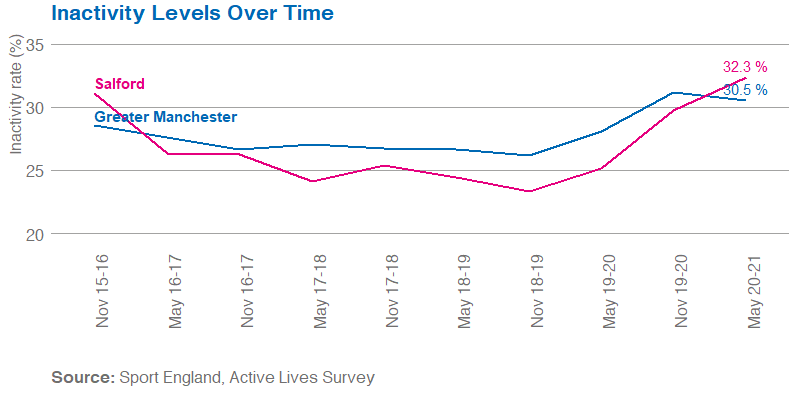Salford Adult Activity Levels May 2020-21
The latest Active Lives results published by Sport England show that 67.7% of adults in Salford are active for at least 30 minutes a week, equating to 141,800 adults moving; a decrease of 12,700 from the survey 12 months ago.
Salford Overview
67.7% of adults in Salford are now moving (active and fairly active), this equates to 141,800 adults. Since Active Lives launched, November 2015-16, inactivity in Salford has increased by 1.3%, meanwhile in Greater Manchester the rate has increased by 2.0%, in the last 12 months it has risen by 7.2% in Salford.

Demographic data
 |
The inactivity gender gap in Salford is 6.7%Since November 15/16 the gender gap has increased by 4.1%. This change is due to an increase in inactivity amongst women (+3.4%) and a decrease in inactivity amongst men (-0.7%). |
 |
The inactivity socio-economic gap in Salford is 32.4%Since November 15/16 the socio-economic gap has increased by 8.6%. This change is due to a larger increase in inactivity amongst lower social groups (+9.1%), NS-SEC 6-8, than the increase seen amongst higher social groups (+0.5%) NS-SEC 1-2. Learn more about activity levels related to socio-economic status here |
 |
The inactivity disability gap in Salford is 17.5%Since November 15/16 the disability gap has decreased by 6.1%. This is due to an increase in inactivity amongst those without a long term limiting disability (+0.7%) and in decrease in inactivity amongst those with a long term limiting disability (-5.4%). Learn more about activity levels related to disability and long term health conditions here |
 |
The inactivity age gap in Salford is 23.0%Since November 15/16 the age gap has decreased by 15.7%. This is a result of inactivity amongst over 75's declining (-12.8%) whilst rates have increased amongst 16 to 34 year olds (+3.0%). |
 |
EthnicityDue to limited sample sizes we have limited ethnicity data across the Greater Manchester boroughs. In Salford 29.2% of those from a White British background are inactive. |
If you have questions about this data please email: [email protected]
All data is rounded to one decimal point, you can access the raw data here.
Published October 2021
